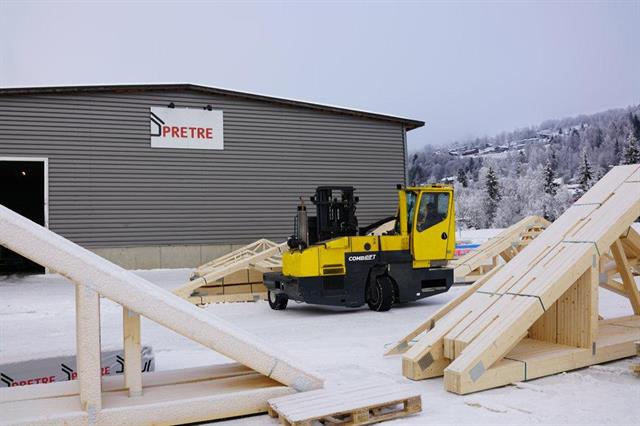 Pretre has to cope with snow for six months each year. |
By Allan LeibowitzThe recent heavy snowfalls in Europe have highlighted the challenges for materials handling in extreme conditions.
As Jungheinrich spokesman Benedikt Nufer sees it, regular forklifts are not designed "to operate in snow masses like we have at the moment in parts of Germany".
"That's an extraordinary weather phenomenon - even for Bavaria," he says, adding that Jungheinrich trucks are designed for a temperature range of -20 degrees to +40 degrees C.
"There are special designs for continuous use in cold stores up to -20 degrees. This cold package includes thin hydraulic oil, heated display, frame completely KTL-primed. We also recommend windscreen heating," he says. "Trucks for outdoor use include weatherproof cabin, electric heating (power 1.5kW) and working lights on the overhead guard."
Frank Bergmann, Linde senior product manager - counterbalance trucks, says his company's diesel-engine forklifts "are particularly well-suited for outdoor use in extreme cold conditions".
Markus Weinberger, Linde's product manager - energy solutions, says electric forklifts with lead-acid batteries are more sensitive to extreme cold because at a lower state of charge the electrolyte threatens to freeze. "This is not the case with the innovative lithium-ion trucks from Linde Material Handling which basically work well at temperatures as low as -35 degrees C - depending on the model. Because of that, they are also suited for use in cold stores. However, charging times are longer if the battery temperature drops below -10 degrees Celsius."
Gianbattista Scaramuzza, senior product strategy manager for warehouse equipment at Yale, explains that freezing temperatures can have a particularly adverse effect on moving parts. "To counteract this, Yale has developed hydraulic lubrication that withstands temperatures down to -30°C without compromising truck performance.
"A range of solutions for specific requirements, for example environments below -30°C or applications where equipment is used continuously within a cold store, is also available through our specialist engineering team."
Toyota Material Handling Europe product planning manager, IC, Paul van de Sype points out that with customers in the North of Europe from Iceland to Norway and the East of Russia, "we know what winter applications with CB trucks are".
CB trucks are designed to operate in negative temperatures: -15 degrees C for IC trucks and -20 degrees C for electric models.
Combilift recently supplied a 12th multidirectional forklift to a customer which has more than its fair share of snow. Pretre, one of Norway's leading manufacturers of roof elements, trusses and pre-cut timber, has snow at its headquarters in Stryn and its other sites in Lillehammer, Trondheim and Kristiansand for over six months of the year.
Managing director Martin McVicar has demonstrated Combilift forklifts in Edmonton, Canada at -40 degree Celsius with a wind chill of -52 degrees.
"The first trucks manufactured by Combilift were exported to Norway, so right from the very start, the trucks were designed for cold, snowy and icy conditions," he explains. "Of the 85 countries that Combilift exports to, quite a few of these experience extremely cold temperatures (including) Rovaniemi in Finland, Serbia in Russia and Fort McMurray in Alberta, Canada."
While forklifts may be able to function in extreme conditions, additional driving precautions are required.
"The decision and responsibility as to when a forklift should not (no longer) be used lies with the fleet operator. Of particular importance is the condition of the tracks and soil. Snow and icy roads are critical factors, as forklift trucks have no winter tyres and snow chains only work under certain conditions," says Linde's Bergmann.
Yale's Scaramuzza stresses the need for cabin heating. "Our customers tell us that their operators perform best when they are comfortable. Keeping operators warm allows the logistics chain to keep moving. Our reach trucks and VNA trucks can be fitted with a heated or fully insulated cabin depending on the individual preference of the customer."
Toyota's van de Sype advises operators to ensure they have LED lights, front and rear, on many different positions on the truck, to light up the working area and also emphasises the need for winter tyres with or without spikes, depending on the application.
McVicar's advice, based on observation of the most extreme conditions, includes travelling with the load as low to the ground as possible.
"Make sure that drivers are aware that reduced speed enhances safety - sudden braking increases the chance of skidding, so should be avoided at all costs. Be extra vigilant when negotiating slopes and, if in doubt, don't," he says.